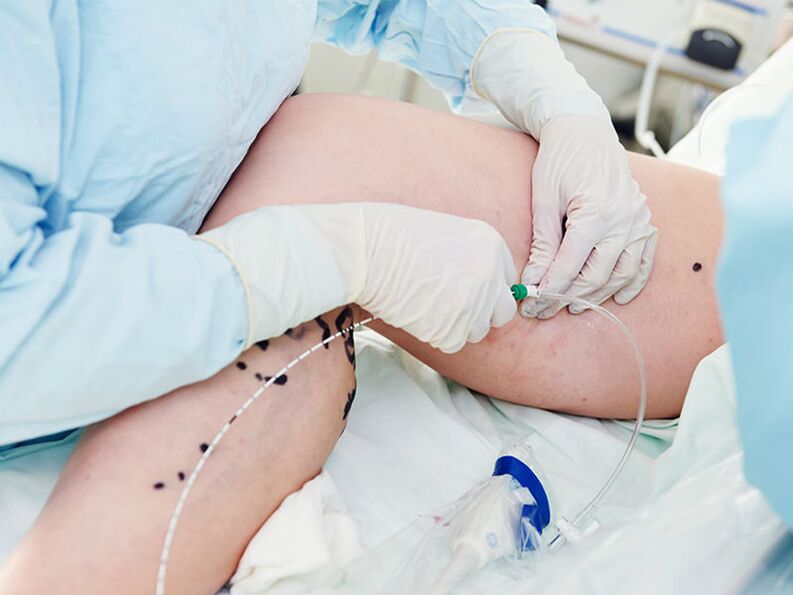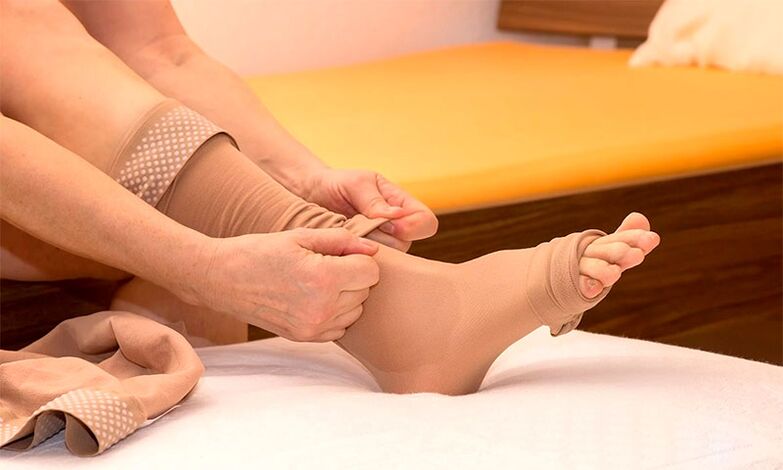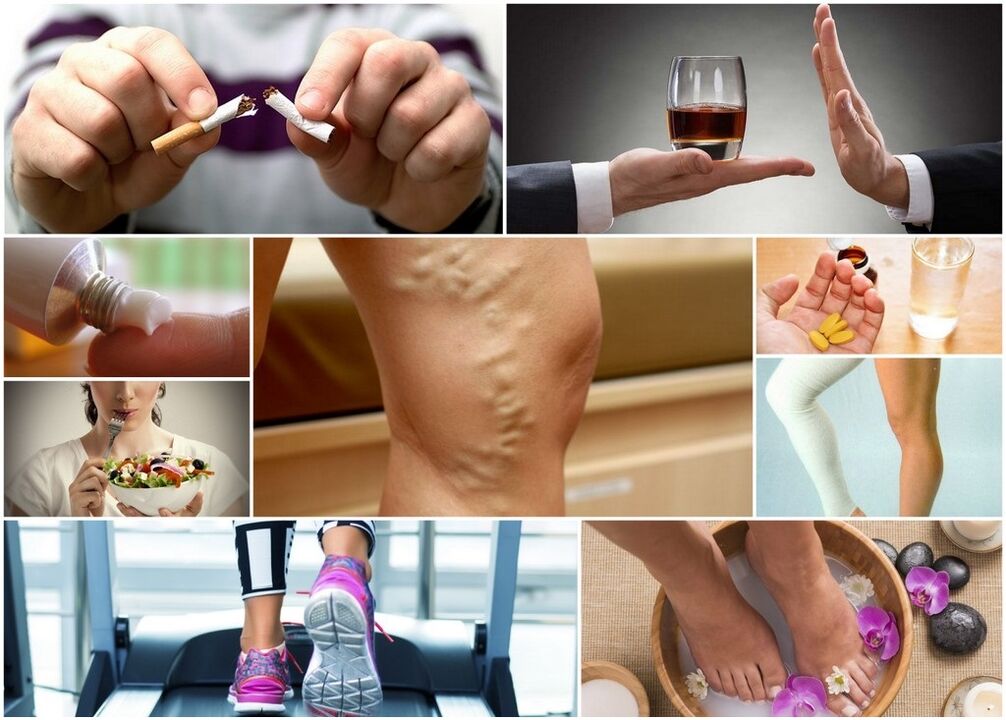Varicose veins (varicose veins) - a state in which veins increase diameter, become cheering. It is most often due to the damaged operation of the ventilate.

Venous system. Characteristics of vein structure.
Venous ships are part of the cardiovascular system, carry blood from peripheral tissues to the heart. The opinion that the venous blood is always flowing through the veins, and the arteries are always running into veins. In fact, it is not always the case. For example, pulmonary arteries carry a veven blood from heart to lungs, and pulmonary veins return from the lungs to the heart of the artery.
In many arteries, blood flows under high pressure, so they have a thick thick wall. On the contrary, in veins, blood pressure is quite low, so their wall thinner and less thick. In the lumen of many veins there are valves - they pass the blood in just one way, which contributes to their progress in the heart. The valves are absent only in the veins of the head and neck, because they are above the heart, the blood goes down freely.
What happens in the veins? The essence of varicose veins.
The walls of the lower extremities are forced to constantly perceive increased loads, because the outflow of blood through these vessels event against gravity. Major mechanisms leading to varicose veins:
- Excessive stretching of the venous wall;
- Valve disorder.
It is far from always possible to say why these pathological changes happen in the veins. There are factors that increase the risk of varicose veins.
Causes of varicose veins
Factors that increase the risk of illness:
- Directing. This factor is present in all people. The legs are farthest from the heart of the body, which is below the rest during standing and walking. Venous blood is the hardest return to the heart from the legs.
- Age. As the risk of varicose veins increases, because the ventilated valves are worn out. They stop closing completely, so a small amount of blood can flow in the opposite direction. He stagnates in the veins of his legs instead of returning to the heart.
- . Women suffer from varicose veins more often than men. This facilitates hormonal changes in the women's body during pregnancy, in postmenopausal, before your period. Women's sex hormones contribute to relaxing the walls of the vein.
- Hormonal replacement therapy and takes oral contraception.
- Heredity. The more members of your family suffer from varicose veins of the lower extremities, which are higher risks.
- Obesity. Additional kilograms contribute to increasing loads to the cardiovascular system. The pressure in the veins increases.
- Standing or sitting for a long time. This leads to stagnation of blood in the veins of the lower body. For example, office workers, surgeons and other people who "standing" and "sitting" work often suffers from varicose veins.
- Pregnancy. During the pregnancy, a woman suffers from varicose veins much more often than in the rest of the time during his life. This is because of some physiological changes in the body of the pregnant woman.

Signs of varicose veins
- Noticeable spread of subcutaneous veins. They increase, become winding, well visible under the skin. Warsely expanded veins usually look like cereals, "worms" blue or dark purple. Such an image appears only with varicose veins located under the skin. If the stricken venous ships located deeper in the fabrics, it is impossible to notice the outside.
- A sense of severity in your legs. Usually occurs or amplifies after intense physical effort, in the evening and night.
- Various unpleasant sensations. It can be combed sensation, a sense of pulsation, tingling, numbness.
- Swelling on your feet. The stagnation of blood in varicose veins leads to the fact that liquid begins to keep and accumulate in tissues. Edem stronger evenings, as a rule, first only on their feet. Like a violation of Veneg blood, swelling extends to the lower legs, hips.
- Muscle cramps. Arise due to blood supply violation in tissues, when a person is long standing.
- The pain in your legs. Not all patients are worried. Intensify with extended standing.
Complications of varicose veins
In most patients, varicose veins do not lead to complications. But the following countries may occur:
- Bleeding. In case of skin damage in the area of varicose veins, bleeding occurs, which may not stop for a long time. In such cases, you have to lie down, lift your legs and press on the surface of the bleeding. If the blood still goes, you have to address the doctor.
- Ulcers for varicose veins. Very painful, most often found in ankle. Ulcers appear due to edema and weakened blood supply to tissues in the area of varicose veins. Usually the ulcer was preceded by a pale place on the skin. If this complication occurs, you must immediately contact your doctor.
- Thrombophlebitis for varicose veins. A condition in which blood clots appear on the vein wall and inflammation. In the area of damage, there may be a feeling of heat, redness, pain. Usually, with this complication, the doctor prescribes compression, hospitals.
- Chronic venous disadvantage. A state in which the exchange of oxygen, nutrients and waste products between the skin and blood is disturbed, due to damaged blood supply. Chronic venous lack increases the risk of pathology such as eczema, hard dense skin, triple ulcers.
- Venous eczema (stagnint dermatitis). Skin lesion caused by stagnation of the formation of venous blood and edema. Main symptoms: red places, peeling, itchy in the field of varicose veins.
- The syndrome of restless legs. It is characterized by an unpleasant sensation in legs arising. The patient must constantly execute the movements, which is why sleep is often upset.
Compression bedding for varicose veins
Compression socks and elastic bandages with varicose veins that are extended veins, thus improving blood circulation. As a rule, compressive underwear dip your legs around the ankles, and above gradually becomes more free. It helps the blood move through the veins in the direction of the reverse strength of gravity - to the heart.
Many patients note that compression socks and elastic bandages are helped to deal with discomfort, pain, edema.
Despite the fact that compression bedding is helped to improve blood flow and deal with some symptoms, does not heal varicose veins. During his studies, ambiguous results were obtained, so scientists cannot say whether compression socks help remove or prevent varicose veins.

Bedding compression varieties:
- Socks and leggings. The most common type of laundry of ruins compression. Socks arrive to hips, leggings - to the waist. Compression legs are most appropriate because they are firmly fixed and not sliding.
- Golfs. Come to the knees. Often use men. There are different models.
- Elastic bandages. There are different lengths, they can be intended for a bend to the lower leg or lower leg and hips. This is the cheapest, but the most uncomfortable variety of linen compression. The bend must be applied longer than the placing or sock is placed, constantly agrees. The degree of compression is managed manually by regulating the bend power and is not always adequate.
Varicose vein operations
With pronounced varicose veins on their feet, they resort to surgical treatment. Usually the operation is performed under general anesthesia. In most cases, the patient is released from the hospital on the day of surgical intervention. If the operation is spent on two legs, then you may need to spend one night in the hospital.
There are different types of surgical treatment with varicose veins.
Dressing and removing extended veins
Two cuts were made: one in the groin, and the other down, in ankle, knee or second place. In the upper part there is, tied and crossed with a vein. A special thin wire in the lower part is performed through it, after which he retreated together with down. Removing the surface veins will not affect the blood supply to the leg, as its functions will take over deep veins.
Possible complications of dressing and removing veins:
- forming large bleeding;
- bleeding;
- pain;
- Very rare complication is a thrombosis of deep veins.
Performance recovery After such operation in most patients, it occurs within 1-3 weeks. All this time you will need to wear schpepinese socks. If there is a venous insufficiency, longer driving will need to use underwear for compression.
Sclerotherapy
During this procedure, a special substance was introduced in a vein that damages its wall from the inside and leads to the folding of the lumens. Varicose takes place within a few weeks. Sometimes the remedy has to be given several times.
Radio frequency ablation
The technique predicts the warming of the wall of the veins using radio frequency energy. Procedure course:

- A small cut is made above or below the knee and access to Vienna.
- Under the control of ultrasound, a catheter is carried out in the vein (half a flexible tube).
- Then, through the catheter, the doctor spends a probe broadcast by radio frequency energy.
- The energy emitted by the probe warms the wall of the veins inside, causes its combustion and closure of a lumon container.
Usually this operation is performed under local anesthesia, without anesthesia. During the procedure, the patient may experience small unpleasant sensations that resemble pins injections. Sometimes a small skin stick happens. Within a few weeks after the radio frequency ablation, the compression beds must be worn.
Treatment of varicose veins with laser
The closure of the lumen veins can also be caused by radiation of the wall inside with the laser. Procedure course:
- The catheter is introduced in the patient's vein.
- The source of laser radiation is done through the catheter to Vienna.
- Laser causes heating of veins, burns of their walls inside and lumen ceiling.
- The surgeon directs laser beams under ultrasound control and gradually burns the wall of the vein.
As a rule, the treatment of varicose veins with laser is performed under local anesthesia. The procedure is effective in 98% of cases.
Exercises for varicose veins
Therapeutic gymnastics can be useful for varicose veins. Below we will consider the simplest set of exercises, but before their application you must certainly consult a doctor. Only your doctor will be able to say exactly which load is not contraindicated and can benefit.
How Gimnastics can help with varicose veins:
- Improving the outflows of venous and lymphatic vessels;
- Improving the supply of the blood of the lower extremities;
- Increasing tons of vein walls;
- improving blood circulation in small vessels;
- Strengthening your leg muscles, increasing their endurance.
Varicose vein massage
The massage can be used for varicose veins, but not always, depends on the degree of seriousness and the presence of complications. Don't deal with self-consideration, it is better to contact a professional massage therapist.
Varicose vein massage helps reduce symptoms such as swelling, convulsions, numbness and other discomfort. It facilitates muscle tension and helps restore the normal tone of the venous walls. With varicose veins, massage is often combined with physiotherapy exercises.
How to deal with varicose veins at home?
There are some measures that can be used independently, at home to slow the advancement of varicose veins and reduce the feeling of discomfort to which accompaniment is accompanied by:

- Physical activity. Walking helps strengthen your leg muscles and improve the outflow of venous blood. Consult your doctor, the level of physical activity that is suitable for you will recommend.
- Maintaining a healthy weight. Follow healthy diet. If you suffer from excess body weight or obesity, try to get rid of an extra pounds. Consult the nutritionist: the specialist will give recommendations on the nature of food that will be optimal in your case.
- The right choice of clothing. Don't wear shoes with high, tight bed linen and clothing that squeeze veins.
- Raising your legs up. It will be very good if you occasionally occasionally rest and lift your legs above the heart level. When you sleep or just lie on the bed, put 3-4 pillows under your feet.
- Breaks with extended sitting or standing. Try moving every 30 minutes.
- Don't put your foot on your feet when you sit down. That is why veins are clenched, blood outflow is even more upset.
Varicose vein prevention
It is impossible to completely prevent varicose veins. Existing preventive measures help only postpone the disease or slowing down his progress, if he is already continued.
- If you have to sit or stand for a long time, be sure to rest. Walk, go. If possible, you can lie down and lift your legs.
- Try to keep your legs in an elevated position when you sit, rest, you sleep. Sometimes it's helpful to go on the couch or on the floor and keep their legs raised, leaning against the wall.
- The more often your legs are greater than the level of heart, the better for their veins.
- Perform physical exercises that help strengthen your leg muscles. Thanks to that, the movement of blood will improve through veins.
- If you have excess or obesity try to lose weight. This will not only reduce the risks of varicose veins, but also positively affect the state of the entire cardiovascular system.
- Do not wear cramped clothes, especially the one that pulls in the waist, groin, legs. Therefore, the outflow of blood through veins can get worse.
- Try wearing high-meters shoes as little as possible. That is why the muscle tone is disturbed, they stop helping push the blood through the veins.

















